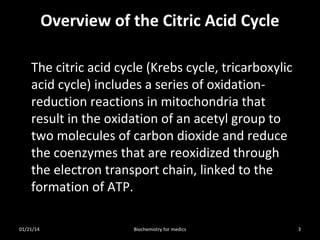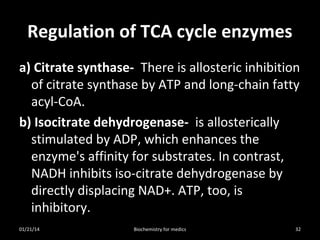The citric acid cycle (TCA cycle) is a series of oxidation-reduction reactions that occur in mitochondria and are the central metabolic hub of the cell. The cycle involves 8 steps to oxidize acetyl groups from carbohydrates, fats, and proteins, producing carbon dioxide, NADH, FADH2, and GTP. This provides energy to drive ATP production through oxidative phosphorylation and the electron transport chain, yielding approximately 12 molecules of ATP per acetyl group. Oxygen is required indirectly to regenerate NAD+ and FADH2.
































![Regulation of TCA cycle enzymes
c) α-ketoglutarate dehydrogenase -α- Ketoglutarate
dehydrogenase is inhibited by succinyl CoA and
NADH. In addition, α-ketoglutarate dehydrogenase is
inhibited by a high energy charge. Thus, the rate of
the cycle is reduced when the cell has a high level of
ATP.
d) Succinate dehydrogenase is inhibited by
oxaloacetate, and the availability of oxaloacetate, as
controlled by malate dehydrogenase, depends on
the [NADH]/[NAD+] ratio.
01/21/14 33
Biochemistry for medics](https://image.slidesharecdn.com/tcacycle-140120110023-phpapp01-240124025918-ec7ac98d/85/tcacycle-140120110023-386382-phpapp01-pdf-33-320.jpg)



















